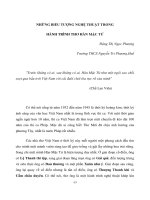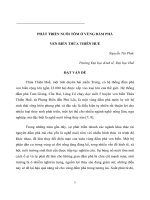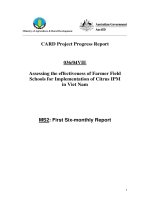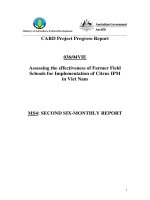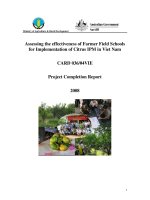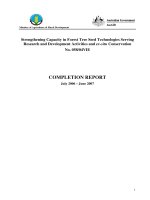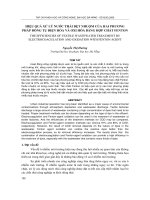Báo cáo nghiên cứu khoa học: "Tỷ lệ mắc ung thư trong dân số của tỉnh Thừa Thiên Huế, Việt Nam, 2001-2009" pot
Bạn đang xem bản rút gọn của tài liệu. Xem và tải ngay bản đầy đủ của tài liệu tại đây (361.18 KB, 11 trang )
499
JOURNAL OF SCIENCE, Hue University, N
0
61, 2010
CANCER INCIDENCE IN THE POPULATION OF THUATHIEN HUE
PROVINCE, VIETNAM, 2001-2009
Nguyen Dinh Tung
Oncology Department of Hue Central Hospital
Lecturer of Hue College of Medicine & Pharmacy
SUMMARY
Hue Central Hospital is the place where the population-based cancer registry was
carried out in Thua thien Hue Province. The purpose of this research was to determine the
cancer incidence in the community, to contribute to the assessment of cancer burden in the
whole country and to analyse the epidemiology characters of some popular cancers in this area.
The active registering procedure has been performed, the data were collected from 14 hospitals
and disposed of according to the international classification for oncology (ICD-O3). The data
was stored in the CANREG software version 4 and was analyzed using EPI-INFO . It was
estimated that 7,324 new cancer cases were registered in the period 2001-2009, which included
55.54% and 44.46% males and females respectively. The highest rate of cancer diseases
belonged to Hue city (37.76%). There was 87.65% of cancer cases diagnosed by cytology or
pathology. The crude rate (CR) was 123.9, the age -standardized rate (ASR) was 173.5
per100,000 inhabitants; those in males and females were 95.3 and 103.9 respectively. The
cancers of liver, stomach, lung, oral cavity and non-Hodgkin lymphoma were the leading ones
in males. Of these, the liver cancer rate is the highest (ARS 34.8).The leading cancers in
females were breast, stomach, lung, liver and oral cavity; and the breast cancer rate is the
highest (ARS 21.7). Cancer diseases have increased among inhabitants after the age of 40
years old in Thua thien Hue. These increased more rapidly in males than in females and the
age-specific rate was highest among the group of 70-75 years old.
Key words: cancer incidence, Thua Thien Hue
1. Introduction
Vietnam is the second most populous country in South East Asia with 85 million
people, and, it is also one of the poorest nations among developing countries in the
world.
There was not much information on the pattern of cancer incidence in Vietnam
until recently. Data was limited to the description of relative frequencies in hospitals
(Luong and Pham, 1964; Luong, 1986, NB Duc 1990, NC Hung 1995). The Hanoi
500
Cancer Registry (in the North of Vietnam) was founded in 1987 (Pham et al., 1993). In
1990, The Cancer Registry was set up in Ho Chi Minh City in the South of Vietnam to
develop the hospital -based registry into a population -based cancer registry. Apart from
this, the Vietnam Cancer Society was also established in 1989 and one of its objectives
was to improve the organization of cancer control activities.
The Oncology Department of Hue Central hospital was set up in 1996. The main
responsibilities of this department are to organize the cancer control program in the
Middle and Highland areas of Vietnam, provide diagnosis, treatment as well as conduct
scientific research on cancers. Hue College of medicine and pharmacy and Hue Central
Hospital are the training centers for medical staff for the whole region. The Hue Cancer
Registry was founded in 2000 to assess the cancer burden in Thua thien Hue province
and data collection of cancer patients was gradually expanded in the Middle area of
Vietnam.
We present in this report the results from this population-based registry for the
period of 9 years between January 2001 and December 2009. During this time, 7,234
new cases were recorded among residents of Thua Thien Hue Province. These data are
of interest not only in providing a picture of the contemporary cancer profile in the
Middle area of Vietnam, but also in permitting a comparison with incidence rates from
the North and the South Regions of Vietnam.
2. Methodology
Thua Thien Hue is a place with diverse cultural heritage. Up to now,
there is no place in Vietnam where so many originally historical vestiges have survived
as in Hue - the ancient capital city. Hue is also one of the most important education
centers in Vietnam. In December 1993, Hue was approved to be a World Cultural
Heritage Site by UNESCO.
Thua thien Hue is located in central Vietnam. It covers 5,054 km
2
and is divided
into 8 districts and 1 capital city (Hue). The estimated population in 2008 was about
1,119,800, comprising 89.9% of Vietnamese (Kinh). Other main ethnicities are Catu
and Ta oi. The climate is tropical, with high humidity and an average temperature of
about 26°C. It’s season of equatorial rains is between October and February.
The population-based registry receives information from the Cancer Registry
division of Hue Central Hospital, the Planning Division of Hue University Hospital, 3
private hospitals, 1 Military hospital and 08 district hospitals (among a total of 14
hospitals). The principal data sources are medical records, including outpatient records
if they exist, logs and reports of diagnostic laboratories (including all histopathology
and cytology services in the city), and the patient logs from polyclinic departments.
Death certificates are not used as a source of information; since cause of death is very
poorly specified (certification by a medical doctor is not required and is relatively rare,
501
except for hospital deaths).
Any case with a permanent address in Thua thien Hue province which had a
diagnosis of 'malignancy' made for the first time was registered. This includes cases
diagnosed by clinical diagnosis alone, even in out patient departments of district
hospitals. Although cancers and tumors without precise specification of whether they
were benign or malignant (ICD-O behaviour codes /2 and /1) were registered, they were
excluded from the analysis in this article - which included cases with tumors specified
as malignant or invasive (behaviour code /3). The date of occurrence of a case is defined
as the date of hospital admission or date of diagnosis. The registry uses a computer with
the CANREG 04 system for data entry and management, which provides a range of
checks on validity of entered data.
The population of this 8-district areas and Hue city in 2008 was taken to
represent the population at risk. The age-sex distribution of this population is shown in
Table 5. Results are presented as numbers of cases by site, sex and age, with crude and
age-standardized rates per 100,000 person-years.
3. Results
Table 1. Number of cases by year and sex
Years 2001
2002
2003
2004
2005
2006
2007
2008
2009
Total
%
Male 362 294 448 386 485 302 287 745 759 4,068
55.54
Female
311 226 280 321 450 312 219 573 564 3,256
44.46
Total 673 520 728 707 935 614 506 1,318
1,323
7,324
100.00
Table 2. Number of cases by year and Address Code
No. Location
2001-
2007
2008 2009 Total %
1 Hue 1,868 472 426 2,766 37.76
2 Phongdien 366 116 105 587 08.01
3 Quangdien 327 96 111 534 07.29
4 Huongtra 440 123 120 683 09.32
5 Phuvang 632 191 237 1,060 14.47
6 Huongthuy 387 94 114 595 08.13
7 Phuloc 460 116 168 794 10.84
8 Aluoi 143 36 29 208 02.83
502
9 Namdong 60 24 13 97 01.32
Total 4,683 1,318 1,323 7,324 100.00
Table 3. Number of cases by Basis Diagnosis
No Basis Diagnosis Number of Cases %
1 Cytology of Metastase 163 01.40
2 Clinical Only 367 03.65
3
Clinical Investigation (X ray,
Ultrasound )
645 08.80
4 Exploratory Surgery/ Endoscopy 2385 32.67
5 Cytology or Haematology 3828 52.14
6 Histology of Primary Tumor 106 01.44
Total 7,324 100.00
Table 4. ICD-O Classification
ICD-O Sites
Male
Female
Total
n % n % % n
C00-C14
Lip, oral cavity ,
Nasopharynx &
Hypopharynx
398 09'82 265 8.17 663 9.09
C15-C26 Digestive Organ 1789 43.97 909 27.91 2698 36.83
C30-C39
Bronchus, lung &
other thoracic
organs
580 14.25 292 8.96 872 11.90
C40,41,45-
49
Bone, Connective,
Soft tissue
166 04.08 173 5.31 339 4.62
C42,C77
Lympho malin &
Leukaemia
358 08.80 207 06.35 565 07.72
C44 Skin 42 01.03 31 00.95 73 01.00
C50 Breast 14 00.34 585 17.96 599 08.17
C51-C58
Cervix, Corpus
Uteri & others
0 00.00 458 14.06 458 06.25
503
C60-C63
Prostate, Testis ,
Penis
122 02.99 0 00.00 122 01.67
C64-C68
Kidney & other
Urinary organs
187 04.60 75 02.30 262 03.59
C69-C72
Brain, Nervous
system
87 02.13 53 01.62 140 01.91
C73-C75
Thyroid gland &
other endocrines
53 01.30 98 03.00 151 02.06
C76-C80 Others 256 06.04 124 04.11 380 05.18
C00-C80 All sites total 4,068 100.00
3,256 100.00
7,324 100.00
Table 5.: Age Standard Population of Thua Thien Hue Province in 2008
Standard pop. : World
Ages Male Female
0-4: 74093 70443 : 12000
5-9: 64507 61287 : 10000
10-14: 60581 57049 : 9000
15-19: 68489 63782 : 9000
20-24: 58245 52851 : 8000
25-29: 48949 45744 : 8000
30-34: 43863 41073 : 6000
35-39: 42312 40620 : 6000
40-44: 35771 36609 : 6000
45-49: 26831 29669 : 6000
50-54: 23348 26522 : 5000
55-59: 15378 18025 : 4000
60-64: 10083 13540 : 4000
65-69: 8763 12762 : 3000
70-74: 7950 12163 : 2000
75 + : 10942 17948 : 2000
??? : 0 0
504
Tot. : 600105 600087: 100000
Table 6. Cancer incidence in Thua Thien Hue
Gender Population
N. of
Cases
%
Crude
Rate
Age
Standard
Rate
Males 600,105,000 745 56.52 123.9 173.5
Females 600,087,000 573 43.48 95.3 103.9
Table 7. Ten of leading cancers in males
No Sites
N. of
Cases
Crude
Rate
ASR
world
ICD
( 10 th )
1 Liver 138 22.9 34.8 C22
2 Stomach 137 22.8 31.3 C16
3 Bronchus, lung 101 16,8 24.6 C33- C34
4 Oral Cavity 50 08.3 11.5 C03-C06
5 Non-Hodgkin Lymphoma 36 06.0 07.5 C82-C85
6 Colon 26 04.3 06.4 C18
7 Esophagus 22 03.7 05.0 C15
8 Connective, Soft Tissue 20 03.3 03.8 C47-C49
9 Myeloid Leukaemia 18 03.0 03.9 C92- C94
10 Bladder 16 02.7 03.9 C67
Table 8. Ten of leading cancer in females
No Sites
N. of
Cases
Crude
Rate
ASR
world
ICD ( 10
th )
1 Breast 111 18.5 21.7 C50
2 Stomach 58 09.6 09.9 C16
3 Bronchus, lung 50 08.3 08.9 C33- C34
4 Liver 35 05.8 06.7 C22
5 Oral Cavity 34 05.7 06.0 C03-C06
505
6 Cervix 30 05.0 05.8 C53
7 Rectum 24 04.0 04.3 C19-C20
8
Non- Hodgkin
Lymphoma
23 03.8 04.0 C82-C85
9 Ovary 19 03.2 03.3 C56
10 Soft Tissue 14 02.3 02.5 C47- C49
Figure 1. Age - specific incidence rates : all sites, males and females
Figure 2. Age- specific incidence rate for Liver cancer
506
0
50
100
150
200
250
300
350
Axis Title
Males
Females
Figure 3. Age-specific incidence rate for Stomach cancer
Figure 4. Age -specific incidence rate for Lung cancer
0
10
20
30
40
50
60
70
80
90
Axis Title
Breast
Cervix
Figure 5. Age-specific incidence rate for Breast & Cervix Cancer
507
4. Discussion
There were 7,324 cases specified as ‘‘malignant’’ [4,068 men (55.54%) and
3,256 women (44.46%)] in the 9 years period between 2001 and 2009 (table 1). The
number of cases in 2008 and 2009 were higher than those in several years ago. From
this fact, we have received funding for this research in the period between 2001 and
2004. Since 2008, we have established the National Cancer Control Program in Thua
Thien Hue province, including Cancer Registry.
To estimate the cancer incidence within a year in Thua Thien Hue, we have
chosen the year 2008 for representative data with 1,318 cases, including 745 men
(56.52% ) and 573 women (43.48%). The crude rate (CR) was 123.9 per 100,000 and
Age Standardized rate (ASR) was 173.5 per 100,000 for men; CR was 95.3 per 100,000
and ASR was 103.9 per 100,000 for women (table 1,5 & 6).The cancer registry in Hanoi
(1990) has found 1975 cases specified as 'malignant' (1163 men and 812 women) in the
3-year period ( 1988-1990). The estimated rates of incidence for all cancers were 86.7
per 100,000 (CR) and 105.1 per 100,000 (ASR)for men; 59.0 per 100,000 (CR) and
63.6 per 100,000 (ASR) for women. Additionally, the results from the population-based
cancer registry in Ho Chi Minh City in the two year period between 1995 and 1996
provided the first information on the incidence of cancer in Southern Vietnam. A total of
4,080 cancer cases in males and 4,338 in females were registered with CR as 89.0 per
100,000, ASR as 130.9 per 100,000 for men and CR as 85.8 per 100,000, ASR as 100.7
per 100,000 for women.
Table 3 shows the most valid basis of diagnosis of the cases registered by tumor
site. Overall, 87,65% of cases have had some microscopic confirmation of the diagnosis,
either histological or cytological and 3,65 % on the basis of clinical examination only.
The sites with the lowest percentages of morphologically were liver and lung cancer. In
1988, the ability of cancer diagnosis in several cancer registries was: Hanoi 53,8%,
Manila, Philippines 60,6%, and Khon Kean, Thailand 34, 5%. The low histological
verification in Khon Kaen is the result of very high rates of liver cancer in males but, in
general, is not very different from other Asian registries.
In men, lung cancer (18,52% of cases, ASR 34.8 per 100,000) was the most
frequent malignancy, followed by cancer of the stomach (18,38% of cancers, ASR 31.3).
Both showed a progressive increase of incidence with the maximum increase in the
oldest age-group. However, the liver cancer incidence was highest among the group
between 60-64 years old. (Figure 2&3). Lung cancer is the third highest in frequency
( 13.55% of cases, ASR 24.6), but for this tumor the average age of incidence is rather
less, with the maximum rate in the age-group 70-74 and a decline thereafter (Figure 4).
The fourth highest in frequency is cancer of the oral cavity and nasopharynx (ASR
11.5 ) and the fifth highest is non- Hodgkin lymphoma (ASR 7.5). In 2001-2004, the
508
Hanoi cancer registry found that incidences of lung cancer (ASR 40.2), stomach cancer
( ASR 30.3) and liver cancer ( ASR 20.0 ) were very different from those from its
cancer registry nearly 20 year ago ( ASR of lung 21.1, stomach 20.8, liver 14.0 ).
In women, breast cancer is by far the most frequent malignancy (19,37% of
cancers, an ASR of 21.7 per 100,000). Incidence rates increase to a maximum number
among age group of 49-64, and then decline (Figure 5). Stomach cancer is the second
highest in frequency (10,12 % of cancers, ASR 9.9), followed by lung cancer (6.8%,
ASR 8.7).
Cervical cancer was formerly reported to be extremely common in Vietnam,
particularly in the South (ASR 26.0 ) which, while similar to that observed elsewhere in
South East Asia and the first cancer in women, it was 4 times greater than that in Hanoi,
but it now declines to the second highest, following by breast cancer. It now ranks the
sixth in this report ( ASR 5.8 ), the fifth cancer in Hanoi in 2007 ( ASR 6.8 ) and the
second cancer in HCM city in 2004 (ASR 16).
Cervical cancer is now generally thought to be related to infection with human.
Papillomavirus (HPV) especially HPV 16 and HPV 18. Cervical cancer
incidence has decreased in the past 10 years. This can be explained by the success of the
cervical cancer screening program in the main cities of Vietnam. Experiences from the
cervix cancer screening program in US during the last 30 years has shown that PAP
Smear can be useful for decreasing cervix cancer incidence, while mammography may
just increase the ability of early detection for breast cancer.
Breast cancer nowadays has become the leading cancer in Vietnam. Research in
Hanoi shown that ASR was 30.0 and 21.7 in this report. This data was increased several
times compare to 10 years ago ( ASR 14.0 and 9.1 ). Although breast cancer is the most
common cancer in women, it is also several times lower when compare to US & Europe
(ASR nearly 100 per 100,000). Thus the low rate currently observed may be associated
with the reproductive factors accompanying previously high levels of fertility (early age
at first pregnancy, multiple births), low caloric intake (relatively late age at menarche,
low body mass) and prolonged breast feeding of infants.
5. Conclusions
The data on cancer incidence confirms the increase of crude rates and ASR
among the population in Thua thien Hue during the last 10 years. It also indicated a
genuine risk for certain cancers, particularly those associated with 'western' lifestyles or
consumption of alcohol and a certain relationship with some virus infection. Cancers of
the digestive organs was the most frequently seen cancer, followed by bronchus -lung
cancer. There was no difference, when compared with the whole country, in the
incidence of breast cancer (the leading cancer in women) and cervical cancer is in the
509
process of decreasing. The difference, comparing with the North, is its higher incidence
of liver cancer and, comparing with the South, is its higher incidence of nasopharynx,
stomach cancer and especially lower incidence of cervical cancer. These findings
provide useful clues for further etiological studies, as well as highlight current priorities
for the cancer control program: hepatitis B vaccination, tobacco control, and early
diagnosis and treatment of breast cancer.
REFERENCES
1. GLOBACAN 2008:
2. Duc Ba Nguyen: Vietnam National Cancer Control Program 2008-2010, Vietnam
Clinical Oncology, (09/2008) : 13-18
3. Duc Ba Nguyen: Cancer Incidence in Hanoi women in period of 1988-2007, Vietnam
Clinical Oncology, (09/2008) : 15-19
4. Hung Chan Nguyen: Action plan for cancer control in Ho Chi Minh City, HCM
Medicine Article, vol 12, N 4, (2008): 1-8
5. Tung Dinh Nguyen: Research on descriptive epidemiology in cancer disease in Thua
thien Hue 2001-2004, Practice Medicine, 6/2006, (2006): 18-30
6. Anh Hoang Pham: Cancer in the population of Hanoi, Vietnam , 1988-1990, Br J
Cancer vol 68, (1993),: 1236-1243
7. Quoc Manh Nguyen: Cancer Incidence in Ho chi Minh City, Vietnam, 1995-1998, Int J
Cancer (1998) : Vol 76: 472-479
